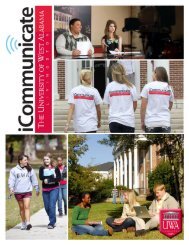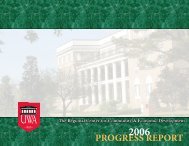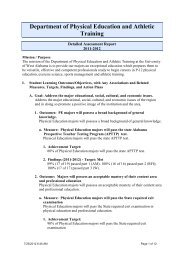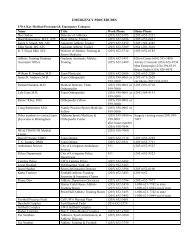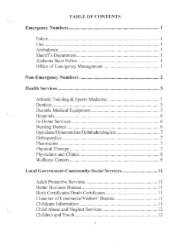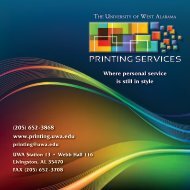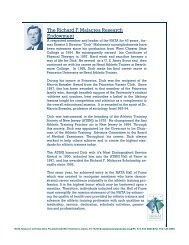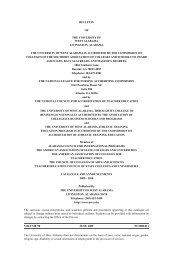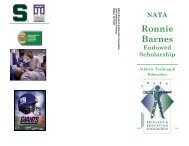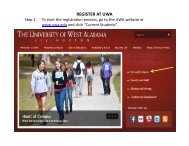table of contents - UWA Athletic Training & Sports Medicine Center
table of contents - UWA Athletic Training & Sports Medicine Center
table of contents - UWA Athletic Training & Sports Medicine Center
Create successful ePaper yourself
Turn your PDF publications into a flip-book with our unique Google optimized e-Paper software.
<strong>UWA</strong> Emergency Action PlanTennis Emergency Procedure (Howard R. Vaughan Tennis Complex)1. When an injury occurs, the athletic trainers should go on to the court to evaluate the injuredathlete. If the injury is life threatening, one <strong>of</strong> the athletic trainers should use an onsitecellular phone or the telephone located in the <strong>UWA</strong> Student Union Building at the Fitnessand Wellness desk to activate the local EMS service and inform them <strong>of</strong> the emergency.Also, call the head athletic trainer or one <strong>of</strong> the senior staff athletic trainers and tell them <strong>of</strong>the injury. He/she should then report back to the attending athletic trainer.2. While one athletic trainer is enacting the EMS system the attending athletic trainer shoulddo a primary survey and check the level <strong>of</strong> consciousness, if possible, or if the case <strong>of</strong> a heador spinal injury hold c-spine and wait. After the non-attending athletic trainer enacts theEMS system and has reported to the attending athletic trainer, he/she should help theattending athletic trainer do a primary survey and/or a secondary survey on the athlete.When that is complete the non-attending student athletic trainer should go and make surethat the ambulance has easy access to the court and that all necessary gates are open via theestablished EMS route.3. The attending athletic trainer must be aware that the athlete could go into shock at any timeafter an injury, so it is very important that the athletic trainer be able to recognize the earlysigns <strong>of</strong> shock and be able to manage it. The athlete should not be moved unless absolutelynecessary.4. When the ambulance arrives at the courts and the EMT's approach the athlete, the attendingathletic trainer should give them all <strong>of</strong> the information gathered such as, the mechanism <strong>of</strong>injury, vital signs, time <strong>of</strong> injury, and progressing level <strong>of</strong> consciousness. When theambulance is preparing to leave one <strong>of</strong> the athletic trainers should have a copy <strong>of</strong> theathlete's insurance and brief medical outline and leave with the athlete to go to the hospital.The attending should make sure they find out where the athlete is being taken by EMS.Location <strong>of</strong> all phonesPhones for emergency actions are available for the following sports at the following locations inthe event that an onsite cellular phone is not accessible:1. If a cellular phone is available it can be used at any location on campus to enact theEMS by dialing 9112. Howard R. Vaughan Tennis Complex: Phone access is located in the <strong>UWA</strong> StudentUnion building. The nearest phone is located just inside the side entrance, bottom floor,at the Fitness and Wellness desk.84




